Competition Begins for Second Transcontinental Line
While the race to complete the Pacific Railroad could perhaps be described as a horse race between two railroad companies, the competition for a transcontinental railroad line across Southern California and the southern part of the nation could perhaps be better described as a game of chess. On one side of the table sat Leland Stanford, Collis P. Huntington, Mark Hopkins, and Charles Crocker, the "Big Four" who had incorporated the Central Pacific and now wanted to control rail transportation within California. On the side sat several challengers who wanted a share of the profit.
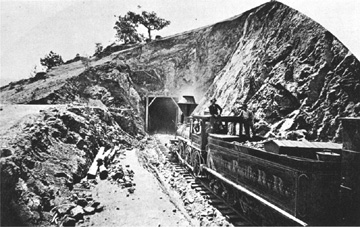 Additional Lines authorized by Congress
Additional Lines authorized by Congress
A group of businessmen in San Francisco, California, led by Timothy Phelps, incorporated the Southern Pacific Railroad Company in December 1865, to build a railroad between San Francisco, Los Angeles and San Diego, then build eastward to the eastern boundary of the state. In July 1866, congress passed a bill authorizing the Southern Pacific Railroad Company, to build a line from San Francisco to meet the Atlantic & Pacific Railroad at the Colorado River near the 35th parallel, to form a second transcontinental rail line. Both companies would receive land grants along the route as long as the line was completed by 1878.
The Atlantic & Pacific Railroad was incorporated by Congress in July 1866 under control of John C. Frémont and associates to build a railroad line near the 35th parallel from Springfield, Missouri west toward the Pacific to meet the Southern Pacific. Following financial difficulties in 1867, the A&P was also transferred to the new owners, which included Clinton B. Fisk of St. Louis. Another 164 miles to Pierce City and 39 miles to Seneca on the state line were completed in 1870, and to Vinita, Oklahoma, in 1871. Additional financial difficulties lead to the sale of the line to the St. Louis–San Francisco Railway in 1876.
The Northern Pacific Railroad Company was chartered by Congress on July 2, 1864 to connect the Great Lakes with the Puget Sound on the Pacific linking Washington and Oregon to the rest of the country. Josiah Perham was elected its first president on December 7, 1864. The company struggled to find financing, ground breaking finally took place on February 15, 1870, at Carlton, Minnesota, 25 miles west of Duluth, Minnesota. The backing of financier Jay Cooke in the summer of 1870 brought momentum to the company. Construction was also started on the pacific coast in 1871.
The Texas Pacific Railway was given a land grant by Congress to build along the 32nd parallel in 1871, between Marshall, Texas, and San Diego, California. In 1872 Thomas Scott became President of the Texas Pacific, and the name was changed to the Texas & Pacific Railway Company. Scott also negotiated with San Diego leaders for a subsidy, the city pledged property for rail facilities in San Diego. The line between Marshall, Longview and Dallas was competed in July 1873, a line from Marshall to Texarkana, Texas, placed in service in Dec. 1873. Unfortunately the Texas Pacific line was never completed to San Diego.
Southern Pacific Line Constructed Eastward through Southern California
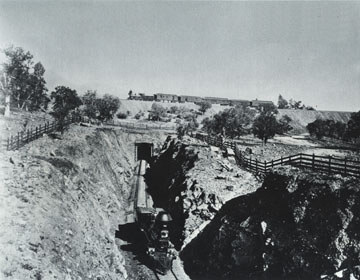 The Southern Pacific acquired the San Francisco & San Jose Railroad following authorization by the state legislature in March. Grading began on the extension southward at 4th Street in San Jose in April 1868, carried out by the Santa Clara & Pajaro Valley Railroad which had been incorporated in January. The line reached Gilroy in March 1869 and Hosister in July 1871.
The Southern Pacific acquired the San Francisco & San Jose Railroad following authorization by the state legislature in March. Grading began on the extension southward at 4th Street in San Jose in April 1868, carried out by the Santa Clara & Pajaro Valley Railroad which had been incorporated in January. The line reached Gilroy in March 1869 and Hosister in July 1871.
The Southern Pacific was purchased by the directors of the Central Pacific, Leland Stanford, Collins P. Huntington, Mark Hopkins, and Charles Crocker in September 1868. The Central Pacific directors feared competition from the Texas Pacific Railway. Planning began on a Southern Pacific line through the southern part of the state on the way to the Colorado River, intending to beat Scott to the state line.
Stanford and the rest of the directors decided not to construct the originally projected line from Tres Pinos to Visalia through the Pacheco pass due to the cost of construction and expense of operating over the mountains.
The Central Pacific began building a more level line southward from Lathrop in December 1869, to connect with the Southern Pacific route. This line was built without the benefit of land grants or other government concessions. Trains reached Modesto in November 1870, Merced in January 1872, Sycamore (Herndon) in April 1872, Fresno in May 1972, and Goshen in August 1972. Practically all of the larger valley towns began as railroad towns along the line. Goshen, 146 miles south of Lathrop became the end of the Central Pacific line, as the line had reached the original survey for Southern Pacific through the San Jaoquin Valley.
The Southern Pacific line was placed in Service to Delano in July 1873.
Southern Pacific links Los Angeles with San Francisco and the East
The SP's main construction efforts were focused in Los Angeles. Pressed for funds, the SP managed to obtain a subsidy in November 1872, from Los Angeles businessmen and residents who feared being left off a main line of a southern transcontinental road. City leaders gave their holdings in the Los Angeles & San Pedro Railroad to the Southern Pacific Railroad. In addition, the county provided a $602,000 cash subsidy to the Southern Pacific and rights of way to build lines to Pomona and Anaheim.
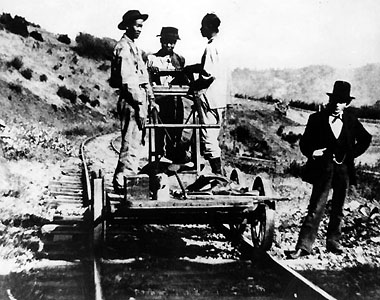 Southern Pacific work crews began construction of a branch line to Anaheim in the summer of 1873, which opened on January 17, 1875.
Southern Pacific work crews began construction of a branch line to Anaheim in the summer of 1873, which opened on January 17, 1875.
A rail line was extended from the LA&SP Station on Alameda Street to Naud Junction, near the junction of Main Street and Alameda Street, where one line continued 22 miles northward reaching San Fernando in April 1874, and the other 29 miles eastward to Spadra, also in April 1874.
Construction in the San Joaquin Valley resumed in April 1874. In October 1874 the SP line reached Sumner (Bakersfield). The tracks were constructed to Caliente in April 1875, at an elevation of 1,291 feet, which remained the southern terminus of the line for more than a year, while more than 3000 American and Chinese men worked on the line through the Tehachapi Pass. At the pass, the railroad crosses over itself forming the Tehachapi Loop, at an elevation of 4,025 feet, a climb of 2,734 feet in 28 miles. A total of 19 tunnels were required. Trains reached the summit in July 1876. The Tehachapi Loop was hailed as one of the greatest engineering feats of its day. Tracks were completed to Mojave in August 1876.
As crews worked their way through the Tehachapi Mountains from the north, constructing the Tehachapi Loop, other crews were building the SP line out of San Fernando, which required digging a tunnel. Construction on the 6,966 foot long tunnel began in March 1875, the longest of its kind at the time, with workers digging round the clock from both ends. The tunnel headings met in July 1876. Tracks were soon heading northward into the canyon.
On September 5, 1876, at Lang Station, near Palmdale, Charles Crocker, President of the Southern Pacific Railroad drove a gold spike to complete the San Joaquin Valley line. Southern California and Los Angeles were linked with San Francisco and the East. 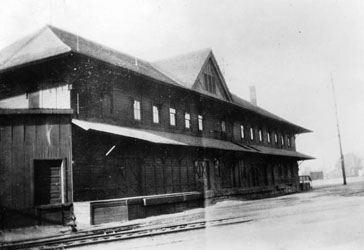 A train from San Francisco reached Los Angeles the same day. Produce and manufactured goods could now be shipped more reasonably and quickly. A land boom began. The down side was that the directors of the Southern Pacific and Central Pacific had monopoly control of the major railroads in California, allowing them to control prices.
A train from San Francisco reached Los Angeles the same day. Produce and manufactured goods could now be shipped more reasonably and quickly. A land boom began. The down side was that the directors of the Southern Pacific and Central Pacific had monopoly control of the major railroads in California, allowing them to control prices.
Southern Pacific Los Angeles Depot
In 1876 SP opened the Los Angeles Junction Station (also known as River Station). The two-story depot offered separate "ladies' and gentlemen's reception and waiting rooms," and by 1883 was upgraded to include a hotel and dining room. The new station was located on the west side of North Spring Street, in an area just northeast of the central city known as "the Cornfield," bound by North Spring Street and North Broadway. Although the original buildings are now gone, today this area is being transformed into the Los Angeles State Historic Park and archeology of the site has revealed foundations from the buildings at this location.
Learn more about Southern Pacific Los Angeles Depots
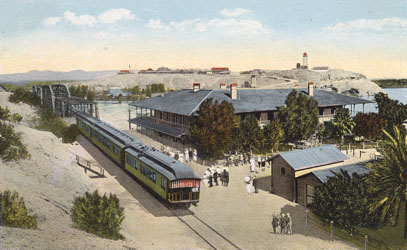 Construction continues East through Southern California
Construction continues East through Southern California
The Southern Pacific proposed building its railroad line eastward from Los Angeles and Spadra through San Bernardino and looked to the city for land for a right of way and for funds but the residents declined. The SP decided to create a new town of Colton, seven miles south of San Bernardino. Track construction was completed through Colton in July 1875.
Construction continued eastward reaching Indian Wells (Indio) in May 1876. The line reached the Colorado River across from Fort Yuma, Arizona in 1877, the end of the distance the charter allowed.
Southern Pacific Construction East of Colorado River
After a few political maneuvers, the SP line was extended into Arizona, reaching Tucson in March 1880. On March 8, 1881 the Southern Pacific and Atchison, Topeka and Santa Fe (ATSF) lines were connected at Deming, New Mexico, forming a transcontinental connection. ATSF and Southern Pacific officials held a brief ceremony and drove a silver spike to commorate the event. The connection at Deming saw little traffic, however, as the SP continued to direct eastbound traffic through a more profitable connection at Ogden, Utah.
Southern Pacific construction crews continued past Deming, completing a line to El Paso, Texas on May 19, 1881. On December 15, 1881 the Southern Pacific connected with the Texas & Pacific at Sierra Blanca, Texas to complete an additional transcontinental railroad connection.
Tracks connected with the the Galveston, Harrisburg and San Antonio Railway at the Pecos River on January 12, 1883. The golden spike was driven by Col. Tom Pierce, the GH&SA president. The Galveston, Harrisburg and San Antonio Railway provided a link with the Texas and New Orleans Railroad at Houston which connected Houston and New Orleans.
The Central Pacific and Southern Pacific had continued to maintain their grip on West Coast railroad traffic, but competition was getting closer. The Sonora Railroad, an ATSF affiliate, had completed its line connecting Guaymas, Mexico on the Pacific Ocean with the the ATFS at Nogales, Arizona on October 25, 1882. The Atlantic & Pacific Railroad Company, half owned by the ATSF, completed its line from Isleta, south of Albuquerque, to the Colorado River at Needles, connecting with the newly built Southern Pacific line from Mojave in August 1883. A California State court order favored the ATSF affiliated California Southern Railroad, allowing construction of the line from San Diego to San Bernardino to be completed in September 1883. The Northern Pacific Railroad Company line connecting the Great Lakes with the Puget Sound on the Pacific, linking Washington and Oregon to the rest of the country opened, with a golden spike ceremony marking completion of the line, on September 8, 1883.
In California competition between railroads began in 1885 when the Santa Fe Route connected with its affiliated California Southern Railroad, which ran from San Diego, northward to Pinacate and San Bernardino. The area's freedom from transportation monopolies was assured. Prices dropped, a ticket from the Mississippi River, which had cost $125 was reduced to $25 or less by 1887. Read more about the ATSF transcontinental railroad line.
Sharing A Heritage Railroad History Train Technology Railroad Operation Railroad Time Museums & Heritage Railroads Railroads Today
